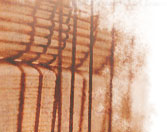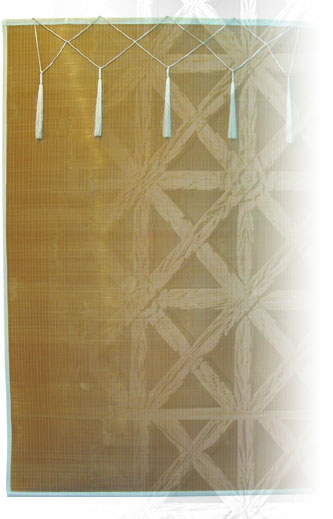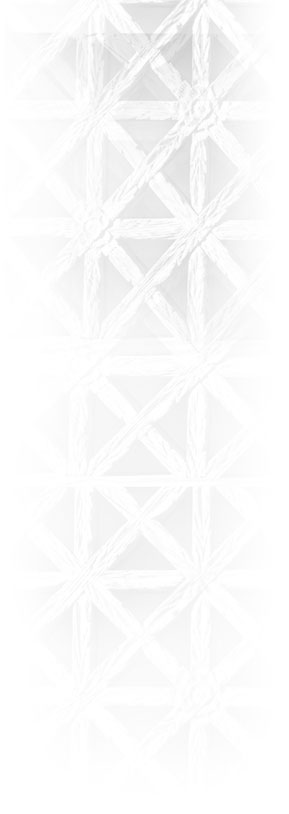| Today, many Koreans cannot tolerate the intense summer heat without air conditioners in their homes and offices. Their ancestors, however, knew how to endure the heat in a far nobler way, which is also friendlier to the environment. The secret was to hang woven bamboo curtains over windows and doors, curtains made by fine artisans who knew how to create a cool atmosphere as well as a fine work of art. Jo Dae-yong is one of those artisans who can combine ancient tradition with modernity to create a piece of magnificence. In Korea, traditional woven curtains are largely divided into three types according to where they are hung: munbal (door screen), changmunbal (window screen) and gamabal (palanquin screen). Most craftsmen prefer to use bamboo or reeds to make curtains. To weave a bamboo screen, one needs to have thin bamboo strips, which, after repeated polishing that involves the use of a device called soeteul (iron frame), should come out “as fine as silk.” Weaving a bamboo screen, therefore, is often compared with weaving silk. Although Korean traditional curtains are often compared with those made in China and Japan, there are differences that make them unique. Traditionally, Chinese people preferred beads for their curtains, and while both Koreans and Japanese favor bamboo, the Korean bamboo curtains are woven with finer strips than their Japanese counterparts. Design preferences also contrast: Chinese patterns are complex and colorful, while Japanese motifs are simplified, a trait that some Koreans find uninteresting. Korean designs, on the other hand, often contain distinctive patterns or images with auspicious meaning. Generally, there are two design techniques for bamboo curtains: one is to weave threads into the curtain, and the other to paint directly onto the curtain with Chinese ink after it has been woven. The most favorite ‘thread’ design is a turtle, while painted designs are mostly of auspicious Chinese characters such as joy, fortune, wealth and honor. The ink is mixed with hide glue or egg before painting to ensure strong adhesion Koreans believed that by hanging a curtain over the entrance of a house or a room, separating the inner sanctions from the outside world, kept evil forces from entering. Oftentimes curtains were painted red, the color that was believed to have magical powers to repulse dark forces. The use of these red curtains (juryeom) was particularly widespread in the royal palaces of the Joseon Dynasty. Of the many varieties of bamboo, the one that is used for making Korean traditional bamboo screens is called wangdae (‘king bamboo’), the largest of the bamboo species, which is widely available in Korea. The ideal harvest season is in winter, between the 12th lunar month and the 1st lunar month of the following year. Producing fine strips from wangdae is laborious, but weavers prefer it to other types of bamboo because it yields even, clean strips with a superb natural color. The harvested bamboo needs to be dried before it’s cut into strips only 1mm thick, which are then filed down to an incredible 0.8mm thickness. After this arduous process is over, the bamboo strips become juksa (‘bamboo threads’) and are ready to be woven. Bamboo curtains weavers take a staggering amount of time and effort to produce such fine strips. The work of ‘spinning threads’ out of completely dried bamboo requires extraordinary diligence and concentration as well as an extremely high level of skill. It is a huge task that demands one’s mental and physical ability in its entirety, and weavers suffer from wearing out their fingerprints several times before mastering the skill. Viewers who watch the process of bamboo screens weaving hold their breath with every movement the craftsman makes because just one mistake of his finger can mean he must restart the whole procedure. The figures are also astounding. A normal-size screen requires about 2,500 bamboo strips, corresponding to approximately 100 bamboo canes, over 300,000 hand movements, and takes about three or four months to complete. The works of art created by Jo Dae-yong, and the 140-year history of weaving by four generations of his family, should be acknowledged and praised. Jo Dae-yong and his ancestors are also admired for the diversity of designs they developed. The traditional designs before their family became bamboo screen craftsmen were limited to a couple of Chinese characters such as joy (hui) and longevity (su). But Jo’s father developed several more characters as well as the turtle motif, which Jo further refined. Jo, himself, followed in his father’s footsteps and developed many new motifs, including the intricate ‘net pattern.’ As an artist seeking to preserve the traditional art and create new users of bamboo curtains, Jo Dae-yong is keenly interested in achieving the balance between the traditional and the modern in his art. The basis of his work lies in the skills he learned from his father and grandfather, but the works he produces today clearly reflect modern sensibility. With his many prestigious awards, his appointment as a Master Craftsman, the designation of his art as an ‘Important Intangible Cultural Property,’ his skill at producing fine strips only 0.5mm-0.8mm in diameter, as well as his weaving of intricate designs into a curtain clearly show that he is a master artist of our time. A woven bamboo curtain was an essential household item for most Koreans in the past, from common folks to the royal family, by providing them with a cool retreat in the heat of summer. At the same time, it was a piece of art that helped them reflect on their inner lives and look out to the world beyond. Master Craftsman Jo Dae-yong weaves bamboo curtains to give modern Koreans a glimpse of the past through his wonderful screens. |
View the master's works |


















